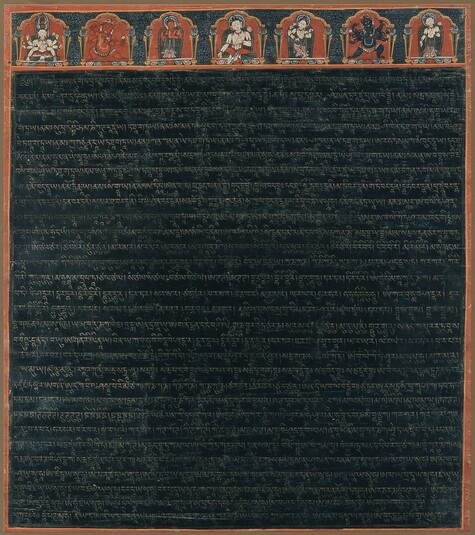
Item: Avalokiteshvara (Bodhisattva & Buddhist Deity) - Amoghapasha (Unfailing Lasso)
| Origin Location | Tibet |
|---|---|
| Lineages | Buddhist |
| Material | Ground Mineral Pigment on Cotton |
| Collection | Anna Maria Rossi & Fabio Rossi |
Alternate Names: Lokeshvara Avalokita Lokanata Lokanatha Mahakarunika
Classification: Deity
Appearance: Peaceful
Gender: Male
Amoghapasha, Five Deities (Tibetan: don yo shag pa. English: Unfailing Lasso): five registers from the top of a set of five paintings. The lower and main portion of each painting is the Amoghapasha Dharani Sutra written on a black background. (See deity identification key).
At the center of each of the four registers sits Lokeshvara (Avalokiteshvara), white, with one face and two hands. Standing at the left is Red Amoghapasha followed by the wrathful red Hayagriva. On the right stands White Bhrikuti followed by the wrathful black Ekajati. Each of the four registers have these same deities arranged in the identical order and appearance. It is these five deities that constitute the Five Deity Amoghapasha (mandala).
Placed at the ends of the four registers are, in the first and on the left side, Chaturbhuja Avalokiteshvara with four arms and on the right Khasarpani Lokeshvara with two arms. In the second register are a seated Ekadashamukha Lokeshvara with eleven faces and eight arms and on the right a standing White Lokeshvara. In the third register are White Lokeshvara and Yellow Parnashavari with three face sand six arms, in a kneeling posture. In the fourth register are Simhanada Lokeshvara seated on a lion and a standing Red (Rakta) Lokeshvara.
The four registers exhibited here are only the top portions of four individual works. The lower portion is a text panel that is identical for all four and contains the Amoghapasha Dharani Sutra, a text belonging to the Mahayana Sutra Literature of Northern Buddhism.
Paintings such as these were created to overcome particular obstacles or inauspicious events. The donor could be an individual, a family, or a community either lay or monastic. The reason to paint and copy the Amoghapasha Dharani would generally be determined through a divination performed by a religious figure respected in the community.
Jeff Watt 1-2009
Publication: Quintessence of Returning Tibetan Cultural Relics From Oversea (Painting)
Thematic Sets
Painting Set: Amoghapasha (Five Deity)
Collection of Anna Maria Rossi & Fabio Rossi
Buddhist Deity: Amoghapasha Five Deity
Buddhist Deity: Amoghapasha (Paintings)
Buddhist Deity: Amoghapasha (Two Arms)
Buddhist Deity: Amoghapasha (Masterworks)
Buddhist Deity: Amoghapasha Main Page

